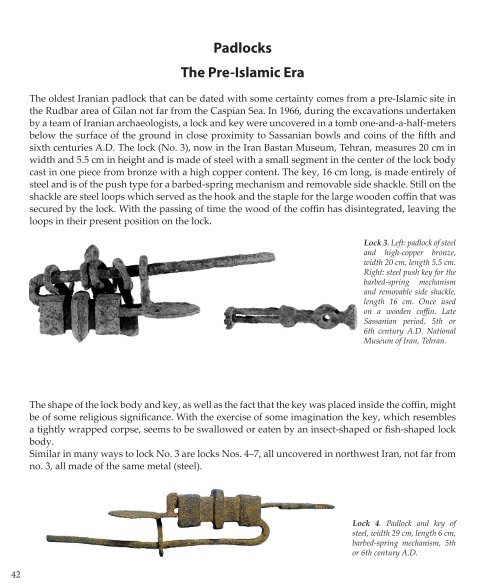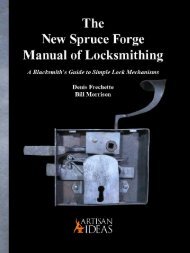Persian Locks: 1500 Years of Iranian Padlocks
In Iran, the padlock was developed in an amazing variety of sizes, shapes, materials, and mechanisms, the likes of which are less frequently encountered in Europe. On the whole, very little attention has been devoted to the history and development of the lock in Iran. Parviz Tanavoli, Iran's leading sculptor, was first attracted to the locks of his own country because of their sculptural qualities. In this beautiful and informative book the author shares with us, in over 500 photos and drawings, the most interesting examples of locks from his famous collection which was first introduced to the American public by the Smithsonian Institute on the occasion of the American Bicentennial. You will also find detailed drawings which clearly illustrate the workings of the various locking mechanisms (e.g., barbed-spring, helical-spring, notched-shackle, hook and revolving catch, etc.) used in the locks in this book. All locks are dated and when known, the place of manufacture is given. A smaller version of this updated and expanded book was published by The Smithsonian Institution in 1976 with the title, "Locks from Iran: Pre-Islamic to Twentieth Century." In 2019 and 2020 the author edited his original book adding new text and a great number of new high-quality photos of locks which have been added to his collection in the 44 years since the first book was published. Hardcover, 144 pages, 10-inches x 8.5-inches, over 500 photos and drawings.
In Iran, the padlock was developed in an amazing variety of sizes, shapes, materials, and mechanisms, the likes of which are less frequently encountered in Europe. On the whole, very little attention has been devoted to the history and development of the lock in Iran.
Parviz Tanavoli, Iran's leading sculptor, was first attracted to the locks of his own country because of their sculptural qualities. In this beautiful and informative book the author shares with us, in over 500 photos and drawings, the most interesting examples of locks from his famous collection which was first introduced to the American public by the Smithsonian Institute on the occasion of the American Bicentennial. You will also find detailed drawings which clearly illustrate the workings of the various locking mechanisms (e.g., barbed-spring, helical-spring, notched-shackle, hook and revolving catch, etc.) used in the locks in this book. All locks are dated and when known, the place of manufacture is given.
A smaller version of this updated and expanded book was published by The Smithsonian Institution in 1976 with the title, "Locks from Iran: Pre-Islamic to Twentieth Century." In 2019 and 2020 the author edited his original book adding new text and a great number of new high-quality photos of locks which have been added to his collection in the 44 years since the first book was published.
Hardcover, 144 pages, 10-inches x 8.5-inches, over 500 photos and drawings.
You also want an ePaper? Increase the reach of your titles
YUMPU automatically turns print PDFs into web optimized ePapers that Google loves.
<strong>Padlocks</strong><br />
The Pre-Islamic Era<br />
The oldest <strong>Iranian</strong> padlock that can be dated with some certainty comes from a pre-Islamic site in<br />
the Rudbar area <strong>of</strong> Gilan not far from the Caspian Sea. In 1966, during the excavations undertaken<br />
by a team <strong>of</strong> <strong>Iranian</strong> archaeologists, a lock and key were uncovered in a tomb one-and-a-half-meters<br />
below the surface <strong>of</strong> the ground in close proximity to Sassanian bowls and coins <strong>of</strong> the fifth and<br />
sixth centuries A.D. The lock (No. 3), now in the Iran Bastan Museum, Tehran, measures 20 cm in<br />
width and 5.5 cm in height and is made <strong>of</strong> steel with a small segment in the center <strong>of</strong> the lock body<br />
cast in one piece from bronze with a high copper content. The key, 16 cm long, is made entirely <strong>of</strong><br />
steel and is <strong>of</strong> the push type for a barbed-spring mechanism and removable side shackle. Still on the<br />
shackle are steel loops which served as the hook and the staple for the large wooden c<strong>of</strong>fin that was<br />
secured by the lock. With the passing <strong>of</strong> time the wood <strong>of</strong> the c<strong>of</strong>fin has disintegrated, leaving the<br />
loops in their present position on the lock.<br />
Lock 3. Left: padlock <strong>of</strong> steel<br />
and high-copper bronze,<br />
width 20 cm, length 5.5 cm.<br />
Right: steel push key for the<br />
barbed-spring mechanism<br />
and removable side shackle,<br />
length 16 cm. Once used<br />
on a wooden c<strong>of</strong>fin. Late<br />
Sassanian period, 5th or<br />
6th century A.D. National<br />
Museum <strong>of</strong> Iran, Tehran.<br />
The shape <strong>of</strong> the lock body and key, as well as the fact that the key was placed inside the c<strong>of</strong>fin, might<br />
be <strong>of</strong> some religious significance. With the exercise <strong>of</strong> some imagination the key, which resembles<br />
a tightly wrapped corpse, seems to be swallowed or eaten by an insect-shaped or fish-shaped lock<br />
body.<br />
Similar in many ways to lock No. 3 are locks Nos. 4–7, all uncovered in northwest Iran, not far from<br />
no. 3, all made <strong>of</strong> the same metal (steel).<br />
Lock 4. Padlock and key <strong>of</strong><br />
steel, width 29 cm, length 6 cm,<br />
barbed-spring mechanism, 5th<br />
or 6th century A.D.<br />
42










